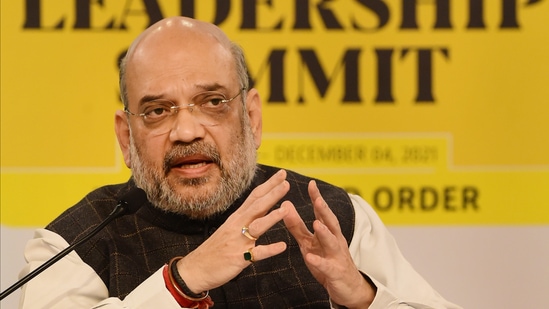Leadership, reforms: Amit Shah lists factors that helped India tackle Covid-19
Shah first emphasised the context in which the pandemic hit, and the concerns that existed about what the pandemic would do to a country of India’s size, diversity and infrastructure capacity.
Giving a glimpse of how the government believes India has battled the threat posed by the pandemic, home minister Amit Shah, speaking at the Hindustan Times Leadership Summit over the weekend, listed out a set of factors — Prime Minister Narendra Modi’s ability to motivate citizens to take ownership of the battle against Covid-19 through self-discipline; prompt remedial action by the government when the pandemic threatened to strain India’s health infrastructure; a concerted vaccination campaign; and simultaneous focus on structural economic reforms.

The minister’s remarks are significant not just because they provide a sense of the government’s thinking through one of the most severe challenges India has faced, but also because they illustrate the political talking points that the Bharatiya Janata Party (BJP) will focus on to respond to questions about its Covid-19 management, especially in the run up to crucial state elections next year.
Shah first emphasised the context in which the pandemic hit, and the concerns that existed about what the pandemic would do to a country of India’s size, diversity and infrastructure capacity. “As we look back, while corona isn’t over yet, I have no hesitation in saying that we have crossed an important phase in the battle against the pandemic. And this is because while in the rest of the world, governments fought against Covid-19, in India, along with the central and state governments, 1.3 billion citizens fought against the pandemic,” said Shah.
The minister emphasized the importance of Modi’s ability to get citizens to exercise self-discipline, especially in the early days of the pandemic, through initiatives such as lighting lamps to applaud corona warriors, or banging utensils to express solidarity, or appealing to citizens consistently to wear masks. It enabled people’s participation, which made it easier for the government to pursue the battle.
It is true that in this regard, compared to even countries such as the United States, where a strong political constituency adopted an anti-science posture, in India, the government’s broad messaging remained aligned with science, and was interspersed with Modi’s political capital. “After Lal Bahadur Shastri, I haven’t seen the country pay such respect to a Prime Minister’s word,” emphasised Shah, in a reference to Shastri’s appeal to citizens to sacrifice a meal during a period of food scarcity.
Two, Shah focused on the government’s proactive measures, with a particular emphasis on how it managed to overcome the oxygen shortage during the second wave. Instead of denying the suffering during the second wave, Shah acknowledged that there was a crisis, a period when there was panic, and where ministers were getting calls with warnings about how a hospital would run out of oxygen within hours.
But he emphasised how the government overcame this difficult situation through mobilising resources from all parts of the world, through optimum utilisation of domestic resources, through ramping up oxygen production 10 times in a short period of time when the country’s supply and demand gap was high, and through meticulous logistical preparation at different steps from storage to transportation of oxygen.
While he did not focus extensively on vaccination in his speech at the summit, Shah referred to the fact that India had succeeded in producing indigenous vaccines. When later asked about the possibility of mandatory vaccination, Shah said this would result in several controversies, and said the pace of vaccination was satisfactory, while admitting that there had been some hesitancy when it came to the second dose.
“Through awareness and personal door to door contact, governments are reaching out to citizens to get vaccinated.” This was both a clear policy message — the government is not considering mandatory vaccination at this stage — and a reminder that the task to secure India from the pandemic had progressed but remained unfinished.
Finally, Shah focused extensively on the economic thinking in government. Claiming that Modi was quite clear, from early on, that the pandemic had to be used as a moment to embark on reforms which would not only help India overcome the pandemic-induced economic contraction, but also leverage opportunities, Shah listed out a range of reformist steps, from production linked incentives in a range of sectors to reforms in coal and mining, from aviation sector reforms and drone and space policy to support for micro, small and medium sector enterprises, from the thrust on infrastructure to setting up project development cells in each ministry and creating an enabling climate for investment.
The home minister pointed out that the government had also incurred greater expenditure, but kept up its fiscal discipline. All these measures, he claimed, had now delivered results visible across a range of parameters from enhanced Goods and Services Tax collection to higher exports, vehicle sales to improved foreign exchange reserves.
While critics will point to gaps in each of the claims, Shah has provided what will be the main contours of the government’s Covid-19 narrative: The pandemic was a once in a century threat. The world had little expectations that India would be able to overcome the crisis. Modi’s ability to inspire and involve people provided the foundation.
There was indeed a crisis during the second wave, but the government promptly responded in adverse circumstances. Vaccination has been an achievement and will remain an area of focus. And economic reforms during the pandemic have helped India, and will continue to push it on a high growth trajectory post the pandemic.
(Through December, HT will run a series of takeaways from the Hindustan Times leadership Summit, conducted in hybrid form between November 30 and December 4)






